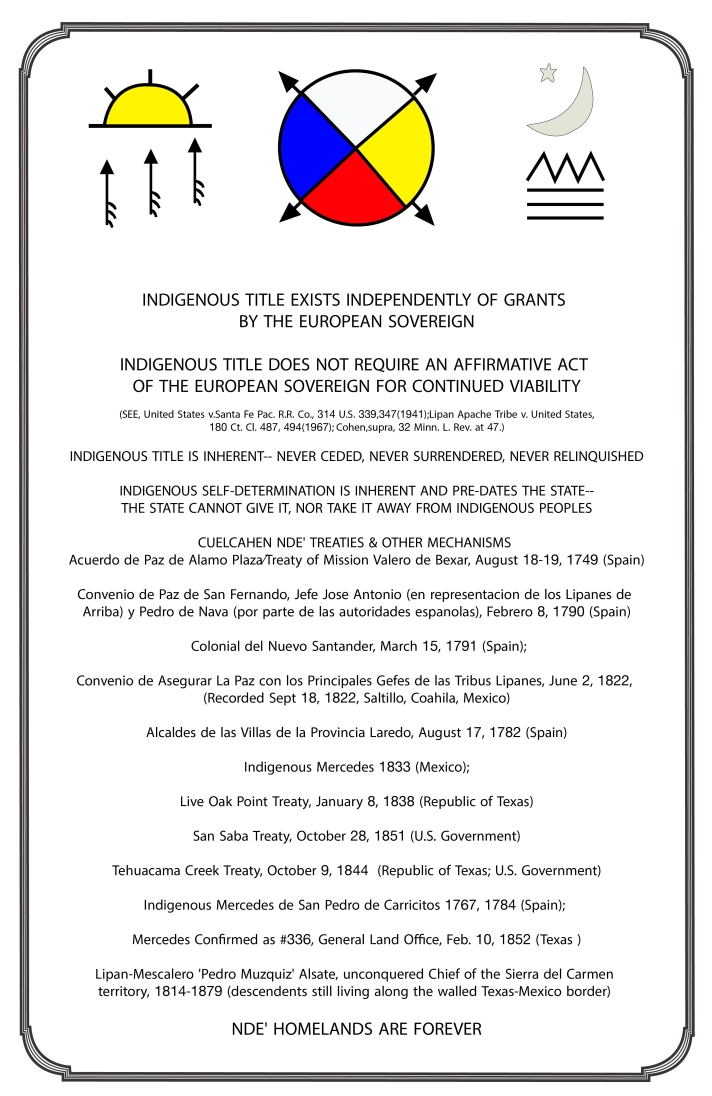via “The US wall is a structure of Indigenous genocide. Begin there.” Lipan Apache Women Defense
“The US wall is a structure of Indigenous genocide. Begin there.” Lipan Apache Women Defense
by Margo Tamez (NdéPenetekaNahuaTlax)
[she/her/hers] [@indigifem-Twitter]
Twelve years after Tamez v. Chertoff (2007), one thing is clear–critical memory and critical thought on the US genocide wall is the object of predation. I must write the case numbers on my body, literally ink them onto my arms, and photograph these (for a publication forthcoming next year), in order to speak a new and different language to the broad masses. This act is necessary. The legal documents tracing the case, while located in a public web page, seem temporally remote to most who just came into consciousness in the last year or so that the US government began constructing questionable barriers in the late ’90s, and then colossal gulag structures along the Texas-Mexico border, in 2007-08. Memory and remembering are prey.
Since the winter of 2007, Ndé isdzané (Lipan Apache) women of Kónitsąąíígokíyaa (Big Water Peoples’ Country; western and lower Rio Grande River) have diligently resisted and refused the United State’s government’s false propaganda and dangerous ideological discourses to rationalize the wall in unceded Ndé homelands.

Twelve years, and three legal processes later, (national, Inter-American, and international), Ndé isdzané continue advancing resistance, activism, and critical methodologies to challenge the illegal seizures and dispossessions of Ndé isdzané lands across the Lower Rio Grande Valley, and to contest the US denial of its collective dispossession of Treaty Lands of the Lipan Apache bands across the entire 1400 Texas-Mexico border.
Lipan Apache title lands are held in legal title amongst all Nde’ peoples. The issues which deeply impact upon Nde’ peoples is the critical law and governance domain of Ndé isdzané rights. Ndé isdzané are crucial in the land-based struggle to confront the state’s violent processes of Indigenous genocide. The “beautiful wall” is not the wall. The wall is the state’s structure, stage, mask, distraction, and instrument. Mesmerization is one of several objectives to secure mass profits and to instil deep division and fractures within and across society.

For Ndé isdzané of Kónitsąąíígokíyaa, twelve years later, we see, experience, witness, and monitor the state’s attacks on memory, logic, and critical thought. We also witness and truth the ways we understand when, how, and to what extent the state’s perspective is taken up by relative Indigenous peoples, especially those with deep, entangling ties to the military, capitalism, and Christianity. We observe and challenge Indigenous peoples’ enacting any form of violence, oppression, suppression, and silencing of Ndé isdzané land title holders of Kónitsąąíígokíyaa in the process of investigating and educating on matters of grave importance–past and present–affecting the land, water, air, and safety of the People.
Targeting Indigenous peoples’ memory, as Enrique Madrid (Jumano Apache) has repeatedly cautioned since the mid-’90s, is one of the state’s crucial tactics to undermine Ndé Kónitsąąíígokíyaa truthing.
Ndé isdzané truthing and memory revitalization on local, collective historical memory identified the wall as part of a nefarious historical pattern and structure of US genocide enacted in Kónitsąąíígokíyaa in successive waves.
The Ndé deeper understanding of the wall as necrotic space of Indigenous abjection prevails as the foundational and critical understanding of what the wall is, does, performs, masks, and enacts.
Today, settler societies, settler states, settler-citizens and their impacts, influences, and affects upon Ndé dispossession in Kónitsąąíígokíyaa–past and ongoing–is a major concern undertaken by the Lipan Apache Women Defense project.
#4thArrowReturns
#NdeisdzaneRise
#WeRemain
#NdeSelfDetermination
#Konitsaaiigokiyaa
#IndigenousTruthingWalls
#IndigenousLandAirWaterPeopleProtection
Margo Tamez (poet and historian) is an enrolled member of the Lipan Apache Band of Texas, is a lineal descendent of Nde’, Comanche, Nahua, Tlaxcaltecan, and related Dene Nation peoples. She is the co-founder of the Lipan Apache Women Defense, a project supported in the Emilio Institute of Indigenous Rights, Responsibility, and Research, a community-based organization founded by Dr. Eloisa Garcia Tamez, located in El Calaboz, Texas, unceded Kónitsąąíígokíyaa. She is the co-founder, and Executive Board Director of Squilwx Apna (the People Now!), a registered Indigenous Squilwx-and-Nde’ Society, located on the Okanagan Indian Band reserve, in British Columbia, Canada, in unceded Squilwx Syilx Okanagan territory. She is an Associate Professor in the Indigenous Studies Program, UBC | Okanagan Campus.




You must be logged in to post a comment.